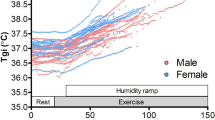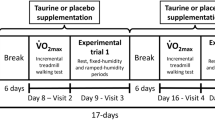Abstract
This study examined the thermoregulatory responses of men (group M) and women (group F) to uncompensable heat stress. In total, 13 M [mean (SD) age 31.8 (4.7) years, mass 82.7 (12.5) kg, height␣1.79␣(0.06) m, surface area to mass ratio 2.46␣(0.18) m2 · kg−1 · 10−2, Dubois surface area 2.01 (0.16) m2, %body fatness 14.6 (3.9)%, V˙O2peak 49.0 (4.8) ml · kg−1 · min−1] and 17 F [23.2 (4.2) years, 62.4 (7.7) kg, 1.65 (0.07) m, 2.71 (0.14) m2 · kg−1 · 10−2, 1.68 (0.13) m2, 20.2 (4.8)%, 43.2 (6.6) ml · kg−1 · min−1, respectively] performed light intermittent exercise (repeated intervals of 15 min of walking at 4.0 km · h−1 followed by 15 min of seated rest) in the heat (40°C, 30% relative humidity) while wearing nuclear, biological, and chemical protective clothing (0.29 m2 ·°C · W−1 or 1.88 clo, Woodcock vapour permeability coefficient 0.33 i m). Group F consisted of eight non-users and nine users of oral contraceptives tested during the early follicular phase of their menstrual cycle. Heart rates were higher for F throughout the session reaching 166.7 (15.9) beats · min−1 at 105 min (n = 13) compared with 145.1 (14.4) beats · min−1 for M. Sweat rates and evaporation rates from the clothing were lower and average skin temperature () was higher for F. The increase in rectal temperature (T re) was significantly faster for the F, increasing 1.52 (0.29)°C after 105 min compared with an increase of 1.37 (0.29)°C for M. Tolerance times were significantly longer for M [142.9 (24.5) min] than for F [119.3 (17.3) min]. Partitional calorimetric estimates of heat storage (S) revealed that although the rate of S was similar between genders [42.1 (6.6) and 46.1 (9.7) W · m−2 for F and M, respectively], S expressed per unit of total mass was significantly lower for F [7.76 (1.44) kJ · kg−1] compared with M [9.45 (1.26) kJ · kg−1]. When subjects were matched for body fatness (n = 8 F and 8 M), tolerance times [124.5 (14.7) and 140.3 (27.4) min for F and M, respectively] and S [8.67 (1.44) and 9.39 (1.05) kJ · kg−1 for F and M, respectively] were not different between the genders. It was concluded that females are at a thermoregulatory disadvantage compared with males when wearing protective clothing and exercising in a hot environment. This disadvantage can be attributed to the lower specific heat of adipose versus non-adipose tissue and a higher percentage body fatness.
Similar content being viewed by others
Author information
Authors and Affiliations
Additional information
Accepted: 31 October 1997
Rights and permissions
About this article
Cite this article
McLellan, T. Sex-related differences in thermoregulatory responses while wearing protective clothing. Eur J Appl Physiol 78, 28–37 (1998). https://doi.org/10.1007/s004210050383
Issue Date:
DOI: https://doi.org/10.1007/s004210050383




